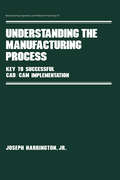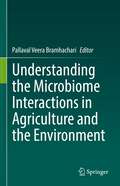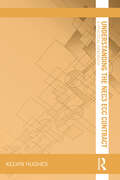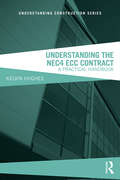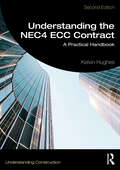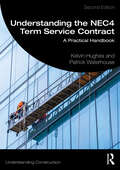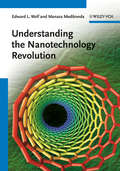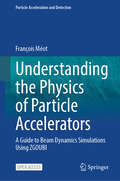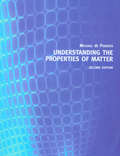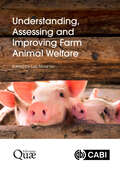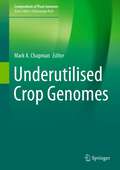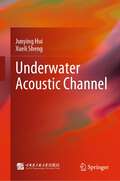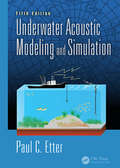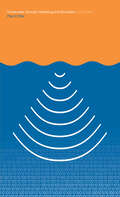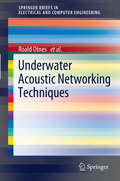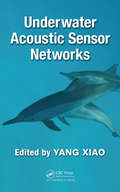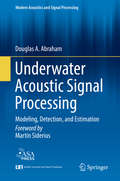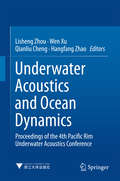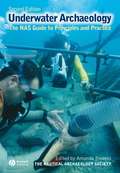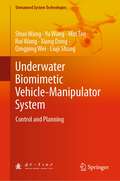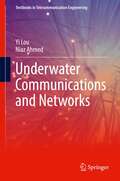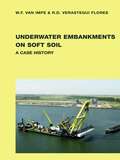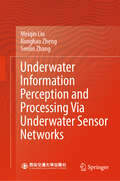- Table View
- List View
Understanding the Manufacturing Process: Key to Successful Cad/cam Implementation
by Joseph Harrington Jr.This book approaches manufacturing as a basic problem of making a desired end-product from bulk raw materials. It encompasses the entire gamut of activities from product concept to maintenance of past products in the field, and everything in between.
Understanding the Metaverse: Applications, Challenges, and the Future (Blockchain Technologies)
by Keshav Kaushik Gunjan ChhabraThis book highlights the numerous potentials and concerns involved with using the metaverse. Furthermore, the project discusses countermeasures to protect any firm from these risks. Insights into practical solutions may assist organizations in using this new business model by raising awareness and preparing them to improve. The book helps readers get insights into technology's future, i.e., the metaverse. The application areas of the metaverse is quite vast, but it also includes security and privacy issues. Addressing the security issues is the need of the hour. Developers are designing the applications, and users are ready to use them, but on the other side, many security issues need to be focused on. Hence, along with the applications, this book helps the reader understand these hidden security and privacy issues.
Understanding the Microbiome Interactions in Agriculture and the Environment
by Pallaval Veera BramhachariThis book illustrates the importance of microbiome interactions in sustainable agriculture and the environment. The chapters of the book provide information pertaining to the vast diversity of microbiomes in many ecosystems and their functional dynamics. The book also discusses bioremediation, space microbiomes, geo microbiomes, coral microbiomes, antibiotic resistomes, and rhizomicrobiome. It also sheds light on the complex syntrophic and other symbiotic interactions between bacteria, protists, plants, and certain animals in agricultural and environmental systems. The book, in turn, provides an understanding of the adaptation, resilience, and evolution of microbial ecosystems. Further, the chapters cover metagenomics analysis of microbiomes of a novel or extreme environments, microbial resilience or temporal fluctuations, symbiosis and co-evolution of the microbiome, and novel microbial interactions in agriculture and environment. Finally, the book elucidates a comprehensive yet representative description of complex structural and functional diversity within the plant and environmental microbiomes to reveal their immense potential. This book covers United Nations Sustainable Developmental Goal 2 towards Zero Hunger.
Understanding the NEC3 ECC Contract: A Practical Handbook (Understanding Construction)
by Kelvin HughesAs usage of the NEC (formerly the New Engineering Contract) family of contracts continues to grow worldwide, so does the importance of understanding its clauses and nuances to everyone working in the built environment. Currently in its third edition, this set of contracts is different to others in concept as well as format, so users may well find themselves needing a helping hand along the way. Understanding the NEC3 ECC Contract uses plain English to lead the reader through the NEC3 Engineering and Construction Contract’s key features, including: main and secondary options the use of early warnings programme provisions payment compensation events preparing and assessing tenders. Common problems experienced when using the Engineering and Construction Contract are signalled to the reader throughout, and the correct way of reading each clause explained. The way the contract effects procurement processes, dispute resolution, project management, and risk management are all addressed in order to direct the user to best practice. Written for construction professionals, by a practicing international construction contract consultant, this handbook is the most straightforward, balanced and practical guide to the NEC3 ECC available. An ideal companion for employers, contractors, project managers, supervisors, engineers, architects, quantity surveyors, subcontractors, and anyone else interested in working successfully with the NEC3 ECC.
Understanding the NEC4 ECC Contract: A Practical Handbook (Understanding Construction)
by Kelvin HughesAs usage of the NEC family of contracts continues to grow worldwide, so does the importance of understanding its clauses and nuances to everyone working in the built environment. Understanding the NEC4 ECC Contract uses plain English to lead the reader through the NEC4 Engineering and Construction Contract’s key features. Chapters cover: The Contractor’s main responsibilities the use of early warnings Contractor’s design Tendering Quality management Payment Liabilities and insurance Termination Avoiding and resolving disputes and much more. Common problems experienced when using the Engineering and Construction Contract are signaled to the reader throughout, and the correct way of reading each clause explained. The way the contract effects procurement processes, dispute resolution, project management, and risk management are all addressed in order to direct the user to best practice. Written for construction professionals, by a practicing international construction contract consultant, this handbook is the most straightforward, balanced and practical guide to the NEC4 ECC available. An ideal companion for employers, contractors, project managers, supervisors, engineers, architects, quantity surveyors, subcontractors, and anyone else interested in working successfully with the NEC4 ECC.
Understanding the NEC4 ECC Contract: A Practical Handbook (Understanding Construction)
by Kelvin HughesAs usage of the NEC family of contracts continues to grow worldwide, so does the importance of understanding its clauses and nuances to everyone working in the built environment. This second edition of Understanding the NEC4 ECC Contract uses plain English to lead the reader through the NEC4 Engineering and Construction Contract’s key features. Chapters cover: Contractor’s main responsibilities The use of early warnings Contractor’s design Tendering Quality management Payment Liabilities and insurance Termination Avoiding and resolving disputes and much more.Common problems experienced when using the Engineering and Construction Contract (ECC) are signalled to the reader throughout, and the correct way of reading each clause explained. The way the contract effects procurement processes, dispute resolution, project management and risk management are all addressed in order to direct the user to best practice. This second edition takes into account the updates to the contract released in 2019, 2020 and 2023, and brings the book up to date with the most current practice.Written for construction professionals, by a practicing international construction contract consultant, this handbook is the most straightforward, balanced and practical guide to the NEC4 ECC available. An ideal companion for employers, contractors, project managers, supervisors, engineers, architects, quantity surveyors, subcontractors and anyone else interested in working successfully with the NEC4 ECC.
Understanding the NEC4 ECC Contract: A Practical Handbook (Understanding Construction)
by Kelvin HughesAs usage of the NEC family of contracts continues to grow worldwide, so does the importance of understanding its clauses and nuances to everyone working in the built environment. This second edition of Understanding the NEC4 ECC Contract uses plain English to lead the reader through the NEC4 Engineering and Construction Contract’s key features. Chapters cover: Contractor’s main responsibilities The use of early warnings Contractor’s design Quality management Payment Liabilities and insurance Termination Avoiding and resolving disputes Tendering Common problems experienced when using the Engineering and Construction Contract (ECC) are signalled to the reader throughout, and the correct way of reading each clause explained. The way the contract effects procurement processes, dispute resolution, project management and risk management are all addressed in order to direct the user to best practice. This second edition takes into account the updates to the contract released in 2019, 2020 and 2023, and brings the book up to date with the most current practice.Written for construction professionals, by a practising international construction contract consultant, this handbook is the most straightforward, balanced and practical guide to the NEC4 ECC available. An ideal companion for employers, contractors, project managers, supervisors, engineers, architects, quantity surveyors, subcontractors and anyone else interested in working successfully with the NEC4 ECC.
Understanding the NEC4 Term Service Contract: A Practical Handbook (Understanding Construction)
by Kelvin Hughes Patrick WaterhouseUse of the NEC4 suite of contracts continues to grow and the new edition of Understanding the NEC4 Term Service Contract includes significant additional materials and changes since its original publication immediately after the initial release of the NEC4 contracts. Experienced authors and construction contracts specialists Kelvin Hughes and Patrick Waterhouse have added numerous practical experiences, case studies, lessons learned and guidance notes which were not available at the time of writing the original book.Covering all the recent updates to the contract and written in plain English, Understanding the NEC4 Term Service Contract offers a practical guide to the use and management of the NEC4 Term Service Contract (TSC). The authors describe the full life of a contract, from the initial selection of options and contract formation through to the operations period and ultimately termination and dispute resolution. Although born of the same stable as the NEC4 construction contracts, the TSC is aimed at maintaining infrastructure and differs significantly from its siblings.This is essential reading for anyone working with the contracts and takes the reader through the important provisions including communications, planning, early warnings, compensation events and payments. It is ideal for clients, contractors and their advisors describing how to deploy the contract successfully.
Understanding the Nanotechnology Revolution
by Edward L. Wolf Manasa MedikondaA unique introduction for general readers to the underlying concepts of nanotechnology, covering a wide spectrum ranging from biology to quantum computing. The material is presented in the simplest possible way, including a few mathematical equations, but not mathematical derivations. It also outlines as simply as possible the major contributions to modern technology of physics-based nanophysical devices, such as the atomic clock, global positioning systems, and magnetic resonance imaging. As a result, readers are able to establish a connection between nanotechnology and day-to-day applications, as well as with advances in information technology based on fast computers, the internet, dense data storage, Google searches, and new concepts for renewable energy harvesting. Also of interest to professionals working in law, finance, or teaching who wish to understand nanotechnology in a broad context, and as general reading for electrical, chemical and computer engineers, materials scientists, applied physicists and mathematicians, as well as for students of these disciplines.
Understanding the Physics of Particle Accelerators: A Guide to Beam Dynamics Simulations Using ZGOUBI (Particle Acceleration and Detection)
by François MéotThis open access book introduces readers to the physics of particle accelerators, by means of beam dynamics simulations and exercises using the computer code ZGOUBI. The respective chapters are organized chronologically and trace the historical development of accelerators from electrostatic columns to storage rings, to the numerous variations on resonant acceleration and focusing techniques, while also addressing side aspects such as synchrotron radiation and spin dynamics. The book offers computer simulations in which readers can manipulate, guide, and accelerate charged particles and particle beams in most types of particle accelerator. By performing these simulation exercises, they will acquire a deeper understanding of charged particle beam optics, accelerator physics and technology, as well as the why and how of when to use one technology or the other. These exercises guide readers through a virtual world of accelerator and beam simulations, and involve e.g. manipulating beams for cancer therapy, producing synchrotron radiation for condensed matter research, accelerating polarized ion beams for nuclear physics research, etc. In addition to acquiring an enhanced grasp of physics, readers will discover the basic theoretical and practical aspects of particle accelerators’ main components: guiding and focusing magnets, radio-wave accelerating cavities, wigglers, etc.
Understanding the Properties of Matter
by Michael de PodestaUnderstanding the Properties of Matter: 2nd Edition takes a unique phenomenological approach to the presentation of matter, materials, and solid-state physics. After an overview of basic ideas and a reminder of the importance of measurement, the author considers in turn gases, solids, liquids, and phase changes. For each topic, the focus is on "what happens." After a preliminary examination of data on the properties of matter, the author raises, then addresses a series of questions concerning the data. It is only in answering these questions that he adopts the theoretical approach to the properties of matter. This approach can reawaken in readers the fascination for the subject that inspired some of the greatest physicists of our age. Examples and extensive exercises reinforce the concepts. A supporting Web site furnishes for free download a plethora of additional materials, including:" Supplementary chapters on the band theory of solids and the magnetic properties of solids" Copies of all the data talbes used in the book, in PDF and spreadsheet formats" Enlarged copies of all figures" A simple molecular dynamics simulation" Animations uillustrating important featrues of key equations" Answers to the end-of-chapter exercisesUnderstanding the Properties of Matter is an entertaining and innovative text accessible at the undergraduate level.
Understanding, Assessing and Improving Farm Animal Welfare
by Luc MounierImproving welfare in farmed animals is good for productivity, consumer demand and, of course, the animals themselves. Covering the current scientific knowledge on the sensitivity and consciousness of animals, this translation of the Le Bien-être des animaux d'élevage series reviews how to understand, assess and then improve farm animal welfare. Beginning with the philosophical and legal history of the consideration of their well-being, it synthesizes this information to build a common reference so that we all share the same notion of what animal welfare actually is. It then evaluates the welfare assessment process, which must be as reliable and objective as possible and require the use of appropriate indicators. Fully outlined in reference documents, these are summarized at the level of specific farming situations for easy reference. Concluding with the different ways of improving animal welfare, the book takes a holistic approach, considering the animals' physical and social environment, the integrated management of their health, the relationship between human and animal, the management of animal suffering, and treatment of animals during transportation and slaughter. Suitable for students and researchers of animal agriculture, animal science and veterinary medicine, this book provides an approachable and comprehensive coverage of this important topic.
Underutilised Crop Genomes (Compendium of Plant Genomes)
by Mark A. ChapmanThis book highlights the uses for underutilized crops, presenting the state-of-the-art in terms of genome sequencing for over 30 crops, previously understudied and under-researched. In a changing climate and with significant pressure on the land, it is the ideal time to be discussing novel crops, with significant biotic and abiotic tolerances and/or rich nutrient profiles for consumers. Previously, the only species with sequenced genomes were high-profile internationally recognized crops, but in the current era genomes are being sequenced for dozens of crops, including those previously classified as underutilized, now being investigated. This book covers food crops, from fruits to tubers, and from grasses to legumes, as well as crops with non-food applications. Some of these crops have draft genomes, and others have polished genomes with extensive resequencing panels. Each chapter tells the story of an individual crop or crop group, written by experts, focusing on the genome data available, revealing more about crop domestication and genetic variation, and the current and future prospects given that this data is now becoming available. It also highlights how even small sequencing projects can provide draft genome sequences suitable for gene discovery, comparative genomics, and identification of molecular markers for understanding these crops further.
Underwater Acoustic Channel
by Junying Hui Xueli ShengThis book introduces sonar system and acoustic channel model, average energy channel, coherent multipath channel, the theoretical basis for the stochastic time-varying space-variant channel, slowly time-varying coherent multipath channel, and reverberation channel. Based on the basic theory of underwater acoustic channels and the various characteristics of the marine acoustic environment factor, this textbook aims to help students understand the impact of the marine acoustic channel on the sonar system. It helps students to grasp underwater acoustic signal processing principles and obtain the ability to solve practical problems in underwater acoustic channel engineering. Finally, it aims at laying a foundation for the further sonar system design. This textbook is recommended for graduate or undergraduate students in the field of sonar signal processing, underwater acoustic engineering, as well as some related subjects of marine technology.
Underwater Acoustic Modeling and Simulation
by Bernt S. AadnoyThis newest edition adds new material to all chapters, especially in mathematical propagation models and special applications and inverse techniques. It has updated environmental-acoustic data in companion tables and core summary tables with the latest underwater acoustic propagation, noise, reverberation, and sonar performance models. Additionally
Underwater Acoustic Modelling and Simulation
by P.C. EtterUnderwater Acoustic Modeling and Simulation examines the translation of our physical understanding of sound in the sea into mathematical models that can simulate acoustic propagation, noise and reverberation in the ocean. These models are used in a variety of research and operational applications to predict and diagnose the performance of complex s
Underwater Acoustic Networking Techniques
by Michele Zorzi Michael Goetz Paul Van Walree Roald Otnes Ivor Nissen Knut Rimstad Thor Husøy Alfred Asterjadhi Paolo CasariThis literature study presents an overview of underwater acoustic networking. It provides a background and describes the state of the art of all networking facets that are relevant for underwater applications. This report serves both as an introduction to the subject and as a summary of existing protocols, providing support and inspiration for the development of network architectures.
Underwater Acoustic Sensor Networks
by Yang XiaoA detailed review of underwater channel characteristics, Underwater Acoustic Sensor Networks investigates the fundamental aspects of underwater communication. Prominent researchers from around the world consider contemporary challenges in the development of underwater acoustic sensor networks (UW-ASNs) and introduce a cross-layer approach for effec
Underwater Acoustic Signal Processing: Modeling, Detection, And Estimation (Modern Acoustics and Signal Processing)
by Douglas A. AbrahamThis book provides comprehensive coverage of the detection and processing of signals in underwater acoustics. Background material on active and passive sonar systems, underwater acoustics, and statistical signal processing makes the book a self-contained and valuable resource for graduate students, researchers, and active practitioners alike. <P><P>Signal detection topics span a range of common signal types including signals of known form such as active sonar or communications signals; signals of unknown form, including passive sonar and narrowband signals; and transient signals such as marine mammal vocalizations. This text, along with its companion volume on beamforming, provides a thorough treatment of underwater acoustic signal processing that speaks to its author’s broad experience in the field.
Underwater Acoustics and Ocean Dynamics
by Wen Xu Lisheng Zhou Qianliu Cheng Hangfang ZhaoThese proceedings are a collection of 16 selected scientific papers and reviews by distinguished international experts that were presented at the 4th Pacific Rim Underwater Acoustics Conference (PRUAC), held in Hangzhou, China in October 2013. The topics discussed at the conference include internal wave observation and prediction; environmental uncertainty and coupling to sound propagation; environmental noise and ocean dynamics; dynamic modeling in acoustic fields; acoustic tomography and ocean parameter estimation; time reversal and matched field processing; underwater acoustic localization and communication as well as measurement instrumentations and platforms. These proceedings provide insights into the latest developments in underwater acoustics, promoting the exchange of ideas for the benefit of future research.
Underwater Archaeology: The NAS Guide to Principles and Practice
by Nautical Archaeology Society (NAS)Underwater Archaeology: The NAS Guide to Principles and Practice provides a comprehensive summary of the archaeological process as applied in an underwater context. Long awaited second edition of what is popularly referred to as the NAS Handbook Provides a practical guide to underwater archaeology: how to get involved, basic principles, essential techniques, project planning and execution, publishing and presenting Fully illustrated with over 100 drawings and new colour graphics New chapters on geophysics, historical research, photography and video, monitoring and maintenance and conservation
Underwater Biomimetic Vehicle-Manipulator System: Control and Planning (Unmanned System Technologies)
by Rui Wang Yu Wang Shuo Wang Min Tan Xiang Dong Qingping Wei Liuji ShangThis book is about the design and control of biomimetic underwater robots. It explains the six aspects of the underwater biomimetic vehicle- manipulator system in detail and provides practical examples. This book is the authors’ long-term exploration of the theoretical and technical issues in the development of the underwater biomimetic vehicle-manipulator system and is written based on more than 15 years of scientific research and practical experience. This book is a helpful reference for the researchers, engineers, master and Ph.D. students in the field of biomimetic underwater robots.
Underwater Communications and Networks (Textbooks in Telecommunication Engineering)
by Yi Lou Niaz AhmedThis textbook covers all related communication technologies of underwater wireless communication, such as acoustic communication, optical communication, and magneto-inductive communication. After describing each technology, the authors relay their pros and cons, as it is essential to learn the underlying mechanism, advancements, and limitations of these techniques. Therefore, this book provides basics fundamentals of the three technologies, their advantages and disadvantages, and their applications. The authors also introduce research trends, pointing readers in the direction of research in the field of underwater wireless communication. The book is an essential textbook for undergraduate and graduate students in the field of underwater communications. The book is also useful as a reference to undergraduate engineering students, science students, and practicing engineers. The book includes end-of-chapter questions and numerical problems.
Underwater Embankments on Soft Soil: A Case History
by William F. Impe R. Daniel Verastegui FloresGround improvement is an established technique in foundation engineering. In recent decades, modern methods of ground improvement have utilised explosives, impact energy, thermal treatment of the soil, vacuum consolidation, vibratory compaction technologies, stabilization and solidification of soft soils, as well as combined systems of ingenious gr
Underwater Information Perception and Processing Via Underwater Sensor Networks
by Meiqin Liu Ronghao Zheng Senlin ZhangThis book highlights the latest advances and trends in information perception and processing of underwater sensor networks (USNs). Underwater sensor networks are networks of autonomous sensor nodes distributed over a given region of water to collaboratively perform a given task. Nearly 70% of the Earth's surface is covered by water, mainly oceans, and more than 80% of the ocean remains unexplored. The emergence of USNs is a new direction in ocean exploration and data collection. USNs offer many applications in both civilian and non-civilian fields. However, due to the characteristics of underwater environments, USNs face challenges such as limited bandwidth, high propagation delay, media access control, routing, resource utilization, power limitation, etc. Researchers have studied and provided many techniques over the past decades to address these issues. This book systematically summarizes the development and covers a wide range of applications of USNs, including mobile node localization, target detection, target recognition, target tracking, sensor scheduling, and environmental monitoring. It also focuses on the introduction of new technologies, including deep reinforcement learning, into underwater information perception and processing. This book is suitable for university lecturers, graduate students, and industry professionals working in the field of USNs.
